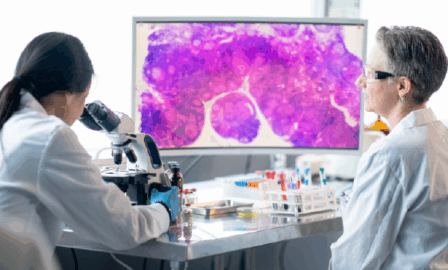The Latest in Cell and Gene Therapy: Recapping the 2025 CGT Summit
Clarkston’s Laurie Stone recently attended the second annual 2025 Cell and Gene Therapy Summit in Orlando, Florida, where researchers, clinicians, industry professionals, and other stakeholders from across the world gathered to discuss the latest in cell and gene therapy (CGT). The three-day conference featured talks and panels about the origins, development, clinical applications, and translational science of cell and gene therapy. Below, Laurie shares her key takeaways and dives further into the themes of the event.
Recapping the 2025 Cell and Gene Therapy Summit
1. Manufacturing Innovations
Manufacturing complexity continues to define the success or failure of CGT programs, with emphasis on adaptive process control, real-time QA, and Quality by Design (QbD) frameworks (QTPP, CQA, CPP, CMA). Companies have transitioned from autologous to allogeneic therapies, aiming to improve scalability and reduce cost, but this switch demands new process parameters and early standardization.
Meanwhile, innovations in AAV manufacturing and IPSC-derived therapies are promising; however, they remain immature and involve a steep learning curve. Rapid turnaround is critical, and businesses need to focus on product quality over process maturity. As companies scale their production process, prioritizing partnerships with contract manufacturing organizations (CMOs) is essential.
Since tech transfer in manufacturing remains a significant hurdle, companies should choose partners with CGT-specific capabilities. Additionally, many biotechnology companies still lack the IT systems needed to scale and support these complex CGT programs. To succeed, companies need to invest in purpose-built, scalable IT platforms that can grow with science, especially as therapies move from clinical proof-of-concept to global commercialization.
2. Commercialization Strategies
Biotech companies face many challenges when bringing a product to market, including regulatory pathways, payment models, and patient-centered design. The gap between discovery and commercialization, referred to as “Valley of Death,” can last over 17 years. This occurs as a result of the highly complex ecosystem created from the connection between product development, evidence generation, infrastructure, and long-term follow-up. To help simplify and decrease the length of R&D, investors are increasingly demanding a fully integrated strategy from bench to bedside. Biotech companies should use a QbD mindset and an early definition of critical parameters to ensure therapies are “fit for use” — not just safe, but commercially viable and scalable.
Regulatory Pathways
Global regulatory pathways differ dramatically, with varying terminology and frameworks surrounding US CGT, EU ATMPs, and Japanese regenerative medicine. Additionally, the current regulatory frameworks are not built for novel therapies, such as engineered stem cells and in vivo CAR-T. Moving forward, biotechnology companies must take the initiative to proactively educate regulators, adapt Chemistry, Manufacturing, and Controls (CMC) strategies, and co-develop expectations to help clear the path towards innovation.
Payment Models
Beyond regulatory hurdles in different regions, local payer models often resist high upfront costs for one-time cures, making it more challenging to bring advanced therapies to market. Financing systems are built around chronic illness, not curative therapy, prompting stakeholders to call for a re-architecture of health economic models. As part of this shift, businesses are starting to use value-based and outcomes-based contracts to tie prices to the therapy’s impact. Warranty models are also being considered with the aim of reducing payer burden and offering risk-sharing mechanisms. Moving forward, it’s critical to communicate proactively with payers about data value to support decision-making.
Patient-Centered Design
A proactive design of the product, patient, and caregiver experience is essential given the complexity of CGTs. Each step, from diagnostics to referrals to treatment at specialized centers, should be mapped to help meet patient needs. The patient’s journey is central to success; biotech companies should design with intention and include partners who can help smooth this path.
3. Funding
Venture capitalists are looking for de-risked, late-stage assets with clear paths to market acceptance. In this new reality, early-stage companies must focus on robust IP protection, global legal alignment, and sustainable channel and market strategies. Ultimately, it’s not just about scientific innovation, but about platforms, systems, and partnerships that scale.
Another source of funding is the Foundation for the NIH (FNIH). This is a 501(c)(3) entity separate from the NIH that has raised over $1.5 billion to support the NIH’s mission. FNIH plays a critical role in designing public-private partnership models to advance therapies and potential cures. FNIH helps leverage collaboration with academia in early tech transfer and industry in late-stage development.
These collaborations and cross-sector partnerships help to ease the challenges of CGT development. Collaborations with the government enable early, ongoing regulatory conversations, which can provide clarity on minimum FDA data requirements. Meanwhile, industry collaborations offer product development expertise, and academia collaborations provide preclinical insight, including animal testing and disease models.
4. Access and Scalability
Because advanced therapies have widespread potential benefits, it’s essential to expand access and reach more patients in need. In-vivo cell engineering bypasses traditional manufacturing, offering greater scalability and potential for use in underserved or resource-limited settings. These advances challenge conventional business models and call for a reassessment of commercialization strategies. By delivering in-vivo therapies through standard clinical methods—such as intravenous, intramuscular, or other accessible routes—companies can expand geographic access, including low-resource and rural areas.
Final Thoughts
The three-day CGT Summit brought together a small, high-caliber group of less than 50 participants from across the U.S. and internationally, including attendees from China, Germany, and the UK. Across intimate, insight-rich sessions, a shared sense of optimism emerged around the rapid progress in cell and gene therapies.
At the same time, speakers emphasized critical work ahead — particularly in navigating regulatory pathways, scaling manufacturing, and designing patient-centered commercialization strategies. The collaborative spirit and cross-sector dialogue underscored the importance of working together to realize the full potential of CGT innovation.
To chat more about these takeaways or other trends and challenges in the cell and gene therapy industry, contact us today.
Subscribe to Clarkston's Insights
Contributions by Natalie Pollock and Hannah Yang



